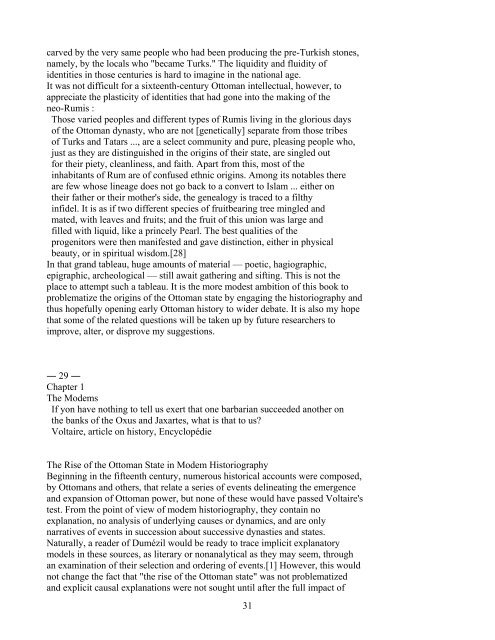Between Two Worlds Kafadar.pdf
Between Two Worlds Kafadar.pdf
Between Two Worlds Kafadar.pdf
You also want an ePaper? Increase the reach of your titles
YUMPU automatically turns print PDFs into web optimized ePapers that Google loves.
carved by the very same people who had been producing the pre-Turkish stones,<br />
namely, by the locals who "became Turks." The liquidity and fluidity of<br />
identities in those centuries is hard to imagine in the national age.<br />
It was not difficult for a sixteenth-century Ottoman intellectual, however, to<br />
appreciate the plasticity of identities that had gone into the making of the<br />
neo-Rumis :<br />
Those varied peoples and different types of Rumis living in the glorious days<br />
of the Ottoman dynasty, who are not [genetically] separate from those tribes<br />
of Turks and Tatars ..., are a select community and pure, pleasing people who,<br />
just as they are distinguished in the origins of their state, are singled out<br />
for their piety, cleanliness, and faith. Apart from this, most of the<br />
inhabitants of Rum are of confused ethnic origins. Among its notables there<br />
are few whose lineage does not go back to a convert to Islam ... either on<br />
their father or their mother's side, the genealogy is traced to a filthy<br />
infidel. It is as if two different species of fruitbearing tree mingled and<br />
mated, with leaves and fruits; and the fruit of this union was large and<br />
filled with liquid, like a princely Pearl. The best qualities of the<br />
progenitors were then manifested and gave distinction, either in physical<br />
beauty, or in spiritual wisdom.[28]<br />
In that grand tableau, huge amounts of material — poetic, hagiographic,<br />
epigraphic, archeological — still await gathering and sifting. This is not the<br />
place to attempt such a tableau. It is the more modest ambition of this book to<br />
problematize the origins of the Ottoman state by engaging the historiography and<br />
thus hopefully opening early Ottoman history to wider debate. It is also my hope<br />
that some of the related questions will be taken up by future researchers to<br />
improve, alter, or disprove my suggestions.<br />
― 29 ―<br />
Chapter 1<br />
The Modems<br />
If yon have nothing to tell us exert that one barbarian succeeded another on<br />
the banks of the Oxus and Jaxartes, what is that to us?<br />
Voltaire, article on history, Encyclopédie<br />
The Rise of the Ottoman State in Modem Historiography<br />
Beginning in the fifteenth century, numerous historical accounts were composed,<br />
by Ottomans and others, that relate a series of events delineating the emergence<br />
and expansion of Ottoman power, but none of these would have passed Voltaire's<br />
test. From the point of view of modem historiography, they contain no<br />
explanation, no analysis of underlying causes or dynamics, and are only<br />
narratives of events in succession about successive dynasties and states.<br />
Naturally, a reader of Dumézil would be ready to trace implicit explanatory<br />
models in these sources, as literary or nonanalytical as they may seem, through<br />
an examination of their selection and ordering of events.[1] However, this would<br />
not change the fact that "the rise of the Ottoman state" was not problematized<br />
and explicit causal explanations were not sought until after the full impact of<br />
31













